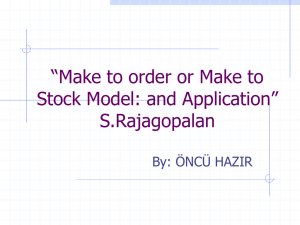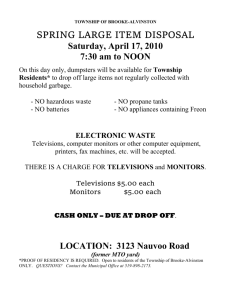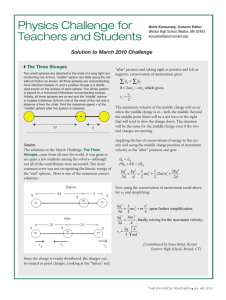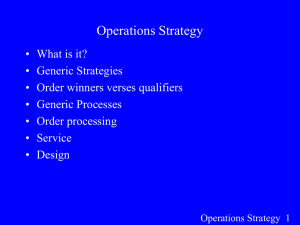.TRADF./WF' 117 corT.1 ENGLISH ONLY
advertisement
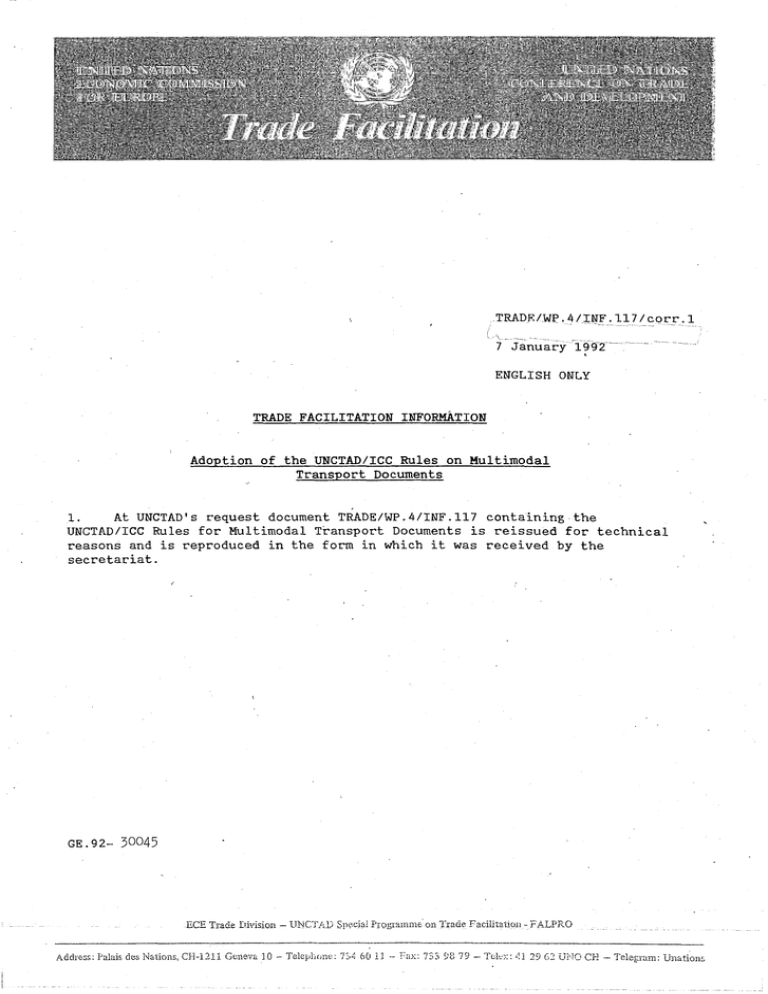
.TRADF./WF' .4/:r:l~"F. 117 I corT.1
ENGLISH ONLY
TRADE FACILITATION INFORMATION
Adoption of the UNCTAD/ICC Rules on Multimodal
Transport Documents
1.
At UNCTAD's request document TRADE/WP.4/INF.117 containing the
UNCTAD/ICC Rules for Multimodal Transport Documents is reissued for technical
reasons and is reproduced in the form in which it was received by the
secretariat.
GE.92- 30045
EeE Trade Division - lJNCTA.D Sp~cj~l PrOgralnnle.' on Jrade Facilit~ti9n - F ALPF~O
Address: Palais des Nations: CH-1211 Geneva ]0 - Telep1ic)ne:
7::;~
6011 - Fax: 733 >'379 -
Tel~:}:: £:}
29 G2 U}",10 Cl-I -
Telef:r~nn: Un&.tion~
TRADE/WP.4/INF.117/Corr.l
TD/B/FAL/INF.117/Corr.l
page 1
English only
UNCTADjICC Rules·
for" Multimodal Transport Documents
'J'Hl\UE/wl'. :.11 INF. Il7 /Corr.1
'I'll/HI Fl\ I,/ I NF. 11 7 /Corr.1
2
INTRODUCTION
I, ,I he I(:C L:lll('Ollll Rules ('or ;\ cOlllhilll.:d Ir;lflS[l(H'1 docul11ent ([CC [1uhlicatlon no 2()Xi which are
based Oil the Cnll'li!i~ j\'!arIUl1le Illterrwtion;1! ((.',\11) "Tokyo Rulc~;" and tile draf't convention known
as tile ."TClv!"-draf'L, elaboratcd by UNI DIU)I'!', 11(\\'C gained world-\Vide recognilion and been incorroraled in 'several widely Llsed <;Iilnclard transport doclIlllcnts sllch as the 1;[/\'1'/\ combineu transrort
bill oflauing and the f1IMCOIINS;\ CO,II/J/I)()(', Pcnding the entry into rOl'l.:e or the Unitecl Nations
Convention on International i'vIullirnod<ll Tr;lflsrort of' Goods of' InO, (the "ivl'!' Convcntion") the
'Cornrnittcc on Shirring or UNCT;\() instructcd the tJNCT/\() secretariat, in close co-operation with
the competent commercial rilrties ilnd illtcl'lnltion;1! hodies, to elaboratc rrovisiQflS for multimodal
transport documents based on the I l£lgue I~L1lcs and the Ilaguc-Yisby Rules as well as cxisting
documents such as the rBL and tile ICC: Unif'orm Rules. The UNCT/\D secretariat consequently
cstublished contact with the commercial rnrtic,~ and a joint UNCT/\D/lCC working group was created
to elaborate a new set of r u l e s . '
.
2,
The Rules arc available to international trade far world-wide application and will be acceptable to
the international banking cornri1unity being fully compatible with the latest revision of the ICC Unifarm Customs and Practice for Documcntary Credits (tJCP) which will become' available in the near
rllturc, I Iovvever, the Rules only cover i1 pnrt 0(' thc clIstomalY' contcnts of an multimodal transport
contract. Thus, an MTO wisiling to lIse tile Rulcs as a has is 1'01' his nlultimodal transport contract
would have to add other clauses dealing with Inattcrs slIch as: ortional stowage, routeing, freight and
charges, liens, both-ta-blame collision, general Lt veragc, jurisdiction and arbitration, ancl applicable law,
to satisfy his particular needs. Such additions could, of course, also be made with respect to matters
covered by the Rules, but only to the extent that they £lre not contradictory thereto.
TRADE/WP.4/INF.117/Corr.l
TD/B/FAL/INF.117/Corr.l
page 3
,
.1
Explanation
Rllle I - Applicahility
The Rules do not apply when they are not referred to. It is possihle to refer to the Rules
even for port to port traffic and when unimodal
transport is intended. .
Parties having referred to the Rules, and
thereby incorporated the Rules into their contract, must avoid inserting stipulations which
derogate from the Rules and which thus would
be contradictory. [t is stated in Rule 1.2 that
the parties by referring to the Rules agree that
the Rules would supersede anything which has'
been stated to the contrary.
Rule 2 - Definitions
It bas been thought that definitions should not
include "multimodal transport" but rather focus
on the "multimodal transport contra.ct".
The definition of "carrier" is included in order
to distinguish any performing carrier - not
identical to the MTO - from the MTO.
The definition of "MT document" includes negotiable, non-negotiahle transport documents
as well as the C(1se where the raper document
has been replaced by electronic data interchange messages.
The defmition of "delivery" only deals with the
situation at the place of destination. Since the
shipper controls the handing over of the good"
for carriage, and problems seldom occur in
practice to determine the beginning of the carrier's period of responsiblity, it is s,ufficient to
refer to the case when the goods are delivered
to the consignee and third parties sub.H'.qllent to
carnage.
Rule 3 - El'identiary effect of tire ;,~forl11ation
contained ll1. the 11l1l/timoda/ transport
document
With respect to the responsibility for information in the MT document, the exrression in art.
or
the Rules
3.4 ofthc-Ilague-Visby Rules, "third party", has
not been used, since the governing factor is
whether or not the consignee has relied and
acted upon the information and not his position
as a "party" or "third party" in relation to the
MTO. In particular. such an expression may
be misleading where the seller has handed over_
the goods to the carrier and the buyer under an
FOB or anFCJ\ contract has concluded the
contract of carriage.
In such a case, the
FOB/FCJ\-buyer- although relying on the information in the ivlT document - could not be
considered a "third party".
Rule 4 - Respo.nsibi!ities of the muftimodal
transport operator
The reriod of responsihility includes the whole
time when the iVlTOis in charge of the goods.
The rarticular problem when the goods are de~
liverecl at destination is covered by the definition of "delivery".
The words "within the scope of his employrnen,t" anc! "for the performance of the contract" would limit the vicarious liahility of the
i'vITO. I Towever, it should be ohserved that
these exrressions may well be given a different
interrretation in difTcrent jurisdictions. In particular, it is uncertain under some laws whether
the MTO would he responsible for theft by his
ernrloyees or other persons acting in the performance of the contract.
The modalities oC delivering the goods to the
consignee have heen clearly set forth with reference to difTcrent types of negotiable MT
documents and to nOIl-negotiable MT documents.
It should he observed that the
modalities of delivery arc different in these
cases. J\ particular reference to the replacement of paper documents by electronic data
in terc!1c1nge messages has been made.
'l'H/\1 11':/1'1 I' .4/ INF .117 /Corr.l
'l'1>/1I/1·'I\I./INT".1l7/Corr.l
I '01 , I' .
·1
!l1ttitiI110d;t1 (1':111"I'(\I'( 1II"'I'i1(lIl 1:111 11T'1)1'" Ihill
e1lle
diligcn<"l' h:l~ h(,I~1l ('X{'f'CI';('d III 1l1i1kL' till'
tr(/nl·I'0,.t nll(,,.I/(o,.
\'t'o;'",1 ,C;I\\'I)rril\' :11 (1)(' ('()!lllllt'III'I'llll'llln[ (Ill'
lile Ilagut' .1I1d Ilagul' VI'ihv Rllk~;. III ;11'1, I V
VO}'i1gc.
The W()lds ",I(,:ltI:t1 ['dtllt ,if prlvlt\' 0('
(·1), ('0I1!;111l :1 1()lq'. lisl (IC tkll'ncc~ \\,hit'h :1[1[,I\'
tile c:trrin" ill1P'" Ihill Ilw :,\1 I() wdl nnlv he
It) Iht' IWrldil (d Ill,' carrier, With (Ill' (':\tT['II()1l
liahk ill ca,c (J[" ;IC[o; 01 IJllll'i';J(1I1'; ()tTlIrrillp on
o[ (he [1:lrll("lil;1I d('[t'llt"n o[ error III 1);1111~:1(\!1I1
Ihe IT/{T/f(I.r.:eri{// Ie . . el III 111'; l:()11l1 1 ;1I1V I [l)"'CVer,
and Ill:ln;q',t:!llCI1( Il[ (ill' vc,';~I'1 (/1;11111(":11 (:It!l()
Ille ! csld( \\'Illlld he Illl: ~:lll1l: III 11111';1 Jllrisdicas well as o( (ire (:Irt, IV (cl) (a) :1Ild (h)), (ile
liollS accordillg (0 gClleral I~rlllcljllcs 0(' law
IlaguC', \fishy RlIlc~ imply ror ill! jlr~lc(lcal pllr,
IVllich would render (:onlr;I('I\lal prOVisions exposes (I li"hili(v n(' (Il,: c;lrrier ('nr rrc~'itlJllCd
empt ill)}. iI pilrl ~ f'ro!ll li;1 hility Illv:tlid 111 cases
, (';\l!lt 01 neglect, In any event, (ilt: Rules wDllld
0(' los~; or dal11il!-(e caused hv persCJllill wilful
have to enS1lrc Ihill the VC(;~;cl·()pC'r;1I111g \11 () • rnisc()(1duct or gr()s~ Ilcgllgence, The hasis of
would ht:nefil ('rotn the same defences which
liahilitv expressed ill the Ilamhllfg Rules :lrt.
would have nprlicd to a COI1lr:1<.:t ('or "
S, I lint! the ;'\'11' ('ol1vcntion art. [(, has heen
unimodnl ~ei1 tra T1.'lport and that a non-vessel
L1sed to sct ('onll the g.cncral principle 0[' a, lioperating ,\It TO (NVO-MTO) would ha vc the
ability ('or l)rCslIlned (':llllt or neglect.
possibility of instituting recourse actions
With respect to liabilit.y for uelay it should be
against the actual (performing) carrier basically
noted that sLlch liability is not expressly reaccording to Rules whieh arc cornpatible with
fen'ed
to in the IIngue- Visby Rules and that, in
the Rules deterrllining his own liability, These
vn
rioLls
jurisdictions, it is uncertain whether the
ohjectives would - although Ilot exactl~'. !Jut
fn
Ilil1!lle-Vislw
Rides cover such liahilitv,
~I ill ror ;dl prilel ieal purposes, he r(,:lclll'd i('llw
RlIle S,I it is ~tiplllilted that the .vfTO ';/lOulel
dd(~nccs 0(' n:lutical fault and 0(' (ire :lrC clc:lrly
he I'c'licvcd ['rom liahiliL\' ('or loss ['()lImvlI1g [i'om
ment.ioned combined with a liahility hased
dcl:lv IInlc~s tllc cOllsignor made iI declaration
upon presumed {'ault or neglect. i\ complete
0(' intercst in timely delivery accepted by the
incorpora tion of the so-called network lin hility
MTO, The rr(lhlem 0(' a possible connict \Vith
principle, taking all modes of transport into
mandatory Inw is taken care of by Rule 13
consideration. would he far too complicated.
containing n general provisi.on dealing with that
In any event, manclatory provisions npl,li'cnble
prohlem.
to unimodal transport would supers9lic I he
Rules (er. Rule I J),
The J larnhurg Rules art. S,J and the MT ConVentiO!l art. [(1..1 contain provisions converting
In view or t'he (~lCt t.hat. the c:lrrier's li:lhility is
rending e1elilY into a right for the claimant to
based upon t.he principle 0(" presilll1eel (;ItIIt. treat the goods as lost. The period has been set
and not on the strict "common carrier" liahility
at tif) days in the \;IT Convention, while the
- it has been deemed unnecess,lry to hlll'dcn the
period is onl~ o() clays in the I farnburg Rules,
text with specific exceptions ('rom liahility 0(' The longer period 0(' l)() days has been chosen
the kind mentioned in the I Inglle Rules (art. IV
('or I he conversion in order to avoid that con(4) (c-p)). Ifowever, should an operator ch (lose
version occur~ under the l11u/timo£ill/ transport
to list in his document some of the t.yricill sitcontr~lct bef'ore sllch a conversion has been
uations for non-liability as Clppear (r(lm the
possible under any underlying Ilflimodal transHague Rules this would not he contr~1dictClry
rort contract.
This \.vill facilitate recourse
in the sense of Rule 1.2 provided the text 0(' actions by the IVI'\'O against his subcontractors.
Rule 5.1 is maintained.
I t should be observed that conversion only
takes place in the absence or proof' that the
f n order to make the basis of liability compatgoods in fact ha vc not been lost.
ible with the Ifague- Visby Rules, an exemption
The stipUlations in Rule 5.5 with, respect to
from liability is expressed in Rule 5.4 uncler the
nssessment of compensation renect the main
heading "Defences for carriage of goods by sea
principle 0(", international conventions and
or inland waterways". f f ere, the Iwo fundanationnl laws dealing with this problem. The
mental defences for nautical ulUlt and fire arc
method to a5sess rartial damage has not been
mentioned.
These defences arc, as in the
dealt with, Individual MTOs may choose to
I Iague- Visby Rules, subject to the overriding
denl with this problem in additional stipulations
requirement that, when the loss or damage has
rn their MT docllments.
resulted from unsea\.vorthiness of the vessel. the
I. ill ";1;(.1 ,
()(
(!t(.
1I1111(;IIWt/(f1
TRADE/WP.4/INF.117/Corr.l
TD/B/FAL/INF.117
page 5
.'5
Rule 6 - Limitation of liahiUty
1nIlWmodal transport operator
(~l
tire
Rule 6 has heen based on the limitation provisions of the I Iague-Visby Rules including the
so-called "container formula" meaning that the
claimant could use the units inside the container for limitatiqn purposes provided they
l1ave been mentioned in the transport document. Since it is intended that the Rules should
also cover multimodal transport not including
sea transport, the CM R limit of liability of 8,33
SDR per kilogramme has in this case heen
used. It should be observed that this provision
does not only "serve to increase the per
kilogramme limitation but also to reduce the
eITect which the" container formula" might lead
to. The average weight of units in containers
in, a number of trades is stated to be about 50
kilogrammes and, if the "cqntainer formula"
applies, this would mean 100 SDR if thelimitation amount equals 2 SO Rand 460.5 Sf) R if
the limitation amount equals R.33 SDR. These
amounts should be compared with the limitation of the I-Iague-Visby Rules which amounts
to 666.67 SO R.
It should be noted that the Rule provides limitation of liability not only for loss of or damage
to the goods and delay in delivery, but also for
cO/lsequentialloss. Physieal damage or loss may
well result in various indirect' losses which under various jurisdictions may not be excluded
by principles to limit the exposure 0(' the liahle
party and a monetary limitation of this type of
liability is therefore appropriate. ,\s has heen
said, the combined unit and per kilogramme
limitation of the IIague-Visby Rules applies
together with ~he so-called "container formula"
using the units inside the container for limitation purposes when they have been mentioned
in the transport document. Also, the higher per
kilogramme amount R.33 Sf) R per kilogramme
applies where the multimodal transport does
not involve sea transport. IIowever, another
monetary limit may apply when loss or damage
could be localized to a particular stage 0(- the
transport, where according to an applicable
international
convention
or
mandatory
national law such other limit of liability is
stipulated. This serves to ensure that both
parties will ha ve access to such higher or lower
limit of liability as they would have had i(- they
had concluded a contract oC carriage for the
relevant segmen~ of the transport.
Liability for delay in delivery or consequential
loss is limjted to an amount not exceeding the
equivalent of the f1'Cight charged under the
multirnodal transport contract. Since it should
not he possihle for the claimant to get the
"freight" limitation in addition to the unit and
per kilogramme limitation, Rule 6.G provides
('or an aggregation of the limits so that they
may never exceed the limit of liahility for total
loss of the goods.
Rule 7 - Loss (~[ the right 0/ the l11111timodal
transport operator to limit liability
The provision in Rule 7 on loss of the right to
limit liability ensures that the right to limit liahility is preserved when the blameworthy
hehaviour has not occurred on the managerial
level hut only on the part of the MTO's servants or agents.
For this purpose the word
"rersona]" has heen added bef'ore the words
"nct or omission". Thus. a distinction is made'
between the MTC),s own behaviour and the
behaviour of others, and the MTO does not
lose his right to limit liability in cases where he
is only vicariously liahle for acts or omissions
of' other persons.
Rule 8 - Liahility
(~[
the consignor
This Rule makes the consignor liable under the
rrinciplc that he is deemed to have guaranteed
to the MTO the accuracy of all information
given with resrect to the goods and, in particular, their dangerous character.
The
consignor's duty to indemnify the MTO against
loss resulting from wrong information in these
resrects is not limited to cases where inaccurate
information is given but also applies when the
information is inadequate. The consignor remains Liahle even if' he has assigned hi,S rights
under the rnultimodal transport contract to
someone else by transferring the document.
The (;lct that the MTO may proceed against
the consignor does not in any way rrevent him
from holding other persons liable' as well, for
instance under the principle that anyone who
tenders goods of a dangerous nature to the
MTO under the arrlicable law could become
liahle in tort.
Rule 9 - Notice
goods
~lloss
.0.[ or damage to tlee
With respect to notice of loss of or damage to
the goods a distinction 'has heen made betw'een
aprarent and non~arparent loss or damage. In
the former case, notice .<;hould be given in writ-
'I'rU\[)E/\~I'.
11 i] NI".] 17 /Corr.1
"I'1l/I1/]"I\!'!
r Nj>'.
I,.HIP
1 17 /Corr.1
I)
Illg t Cl till' :\1 I () wh<,n the gn()<is wCI"e ha nded
to the consignee. In [Ile 1:ltter case, notice
~h(]llld he glv('n wl[hln six CCl!)scclllive d:IVS <\('ter tile day wll'ell the: goods \Vere handed over
tCl the: c()n~igne(;. [n case or I<ltl~ notice, the
'M TO wOlrld IHI VI'. CS(i1 hli~hed a prima ./flril' case
t Cl the G!T(~ (' t t h;Ilit i s I' re S UI1I C d t hat f1 Cl I() ss () r
damage has ()ccurred unless Ihe c()ntfiir~' cOllld
Iw proven hy IhI! cl;lilT1:trH, The RlIle doe'; not
de;1I with act.IO!)S Iw t.he l'vITO agaillst the
consignor and lhcrer(;!'c!)O pcriod ('0;' notice (J('
sllch cia irns has hcc'n provided (or,
0\,('1'
,
.
Rule 1() - Time-lull'
The lime-bar has heen sel at I) months. The
Ilpgue- Visby Rules provide ('nr ;\ onc-ycnr limit
and the MT Convention ("or a two-veal' limit.
A time-bar of 9 months hae! to he 'chosen in
'orcler to ensure that the MTO wOllld have adeqllate possihilit.ies to institute recourse actions
against the performing carricr. I n the absence
0(' any legal provision protecting the MTO's
recourse possibilities as aforesaid, a shorter period has to be chosen than the period \vhich
applies under mandatory law to the performing
carner.
Rule 11 - AppHca!J;lity
ill tort
(~/ tire /'Iflcs to flctioflS
The MTO would also need to he protected
from claims when they relate to the performance of the contract but nevertheless the
claimant seeks to avoid the Rules hy rounding
his claim in tort. The Rule will not work when
there is no contract.uul relationship hetween the
MTO and the claimant. Ilowever, it contains
an important protection ('or the .M"I'O ngninst
a possible circumvention of the Rules by the
person whb has agreed to be bOllnd by the
Rules,
Rule 12 - Applicahmty of the rules to the
multimodal traTlsport operators Sel'J'allts,
agents and other persons employed by hinl
This Rule purports to protect the servants and
agents and other persons employee! hy the
MTO, allti therehy inciirectlv the ,\1'1 () hill{o.;cl[',
by st.ipulating that the silnie protection which
applies to Ihe MTO w(lIt1d:\ls() :1J1plv to tlH'
benefit 0(' "fin), servant, ag,l'Ilt or other Jicrson
whose services tile rlllllrirnocial tr;ln~f1()n orerator has lIsed in order to pcrr-orrll the i'"IT (ontriler". /\Iso in these cases it does nil! matter
\Vheth(~r slIch cl;lirns lire rounded in cot1truct or
in ton. This Rllle is or' the saInt: essence as the
so-called [ [ill1i1li1yn-e[illlses which are lIsually to
he fOllrld in the hills' of lading and ot.her transport docunients. II should he noted t.ltat the
carrier is given tlte sanle protection llnder t.he
Ilnglle-Visby 1(IlIeS everl in thl~ ahsence oC a
clnuse. flut it is uncertain. at'lcast in some jurisdictions, whet her the protection also applies
to "independent COl1ll'tlctors" as distinguished
r'rom "servant.s or :Igenr.s".
It. is part.icularly
import.(II1t. lhat the protection in case 0(' a mu 1tirnodal transport contract is not limited only
to "servants or ngents", since the MTO freCl uen tl y en gages va ri ous su b-con tractors in orperform
the
contract.
In
der
to
Anglo-American law, some difficulties may
arise to make this particular Rule effective in
view or the difTiculties in obtain'ing protection
for third parties hy contractual arrangements.
This might reCluire rartinIlar techniClues in order to obtain the desired protection when English or United States law applies to t.he carriage,
e.g. to stipltlllte thn t the IvlTO, whcn agreeing
with the consignor to apply Rule 12. h3s done
so ;IS an agent or a trustee of the other persons
concerned.
Rule. 13 - III([ITdatol'V
.
I(fHI
This Rulc onlv serves as a reminder. Mandatory provision:, or int.el'lHltional conventions or
n~\tionallaw which may apply to the fTlTlltimot/al
transport contr3ct will supersede the Rules. It
could he argued that the multimoclal transport
contract is Cl contract of its own type and that
therefore no infringement of mandatory law
applicable to lIf1ilT1odal transport could occur.
Ilowevcr, the "conversion" of a unimodal carrier into an MTO may be considered an unacceptable way to avoid mandatory law a,nd that
therefore mandatory l[1\v, in such a case, would
defent some of the stipulations of these Rules.
I f it does, the Rules will hecome inefTective but
only to sueh extent.
TRADE/WP.4/INF.117/Corr.l
TD/B/FAL/INF.117/Corr.l
page 7
7
Tf)S f) f( n.TS.TEXT(R lJ r .ES)
. UNCTADjICC Rules
.for 1\1 uHimodal Transport Documents
1. Applicability
1.1. These Rules apply when they are incorporated, however this is made, in writing, orally or otherwise, into a contract of carriage by reference to the "UNCT;\D/ICC Rules for multimodal transport
documents", irrespective of whether there is a unirnodal or a multimodal transport contract involving
one or several moc)es of transport or whether a document has been issued or not.
1.2. Whenever such a reference is made, the parties agree that these Rules shall supersede any additional terms of the multimodrrl transport contract \vhich are in connict with these Rules, except insofar
as they increase the responsil?ility or obligations of the multimodal transport operator.
2. Definitions
2.1. Multimodal transport contract (multi modal transport contract) metlns a single contract for the
carriage of goods by at least two difTerent modes' of transport.
2.2. l'vlultimodal transport Orertlt0r (MTO) Illerrns any person \vho concludes a multimodal' transport
contract and assumes responsibility for the performance thereof as a carrier.
.
2.3. Carrier means the person who actually performs or undertakes to perform the carriage, or part
thereof, whether he is identical with the l11ultimoclal trrrnsport operator or not.
'
2.4. Consignor means the person who conclucies the multimodal transport contract with the multimodal
transport operator.
2.5. Consignee means the person entitled to receive the goods from the multimodal transport operator.
2.6. Multimoclal transport clocument (f'vIT ciocument) means a document evidencing a multimodal
transport contract and which c[ln be replaced hy el,ectronic data interchange messages insofar as
permitted by applicable law and be,
(a)
issued in a negotiable form or,
(b) issued In a non·negotirrblc forrn indicating a named consignee.
2.7. Taken in charge means thrrt the goods have been handed over to and accepted for carriage by the
MTO.
2.8. Delivery means
(a)
the handing over of the goods to the consignee, or
(b) the placing of tile goods at the disposal of the consignee in accordance with the multi modal transport contract or with the law or usage of the particular trade applicable at the
place of delivery, or.
(c)
the hawling over of the goods to an authority or other third party to Whom, pursuant to
the law or regulations applicable at the place of delivery, the goods must be banded over.
2.9. S[?ecial Drawing Right (SDR) merrns the unit of DC count as derIned by the International Monetary
Fund.
2.10. Goods means tlny property including live llnimrrls as well as containers, pallets or similar artic:Jes
'!'Hl\[)J':/io,ll'. ;1/1 NJi' .117 /Corr.l
'1'll/Il/I"AI./I NJo',] 17 /Corr.l
1)01' 1
"
0('
I~
3.
H
tt:Jnspm( ClI p;J('kilging n()t 'iIIPI)liCd hv the MTO, irrespective of' II'IH'II\('J' ',II(h PJ'lllwi'lV IS (n hL: DJ'
caJ't I\'tI Oil III IltllleJ' deck,
h'l'id(' III hI rJ'
('11('(' I
(~l tire i'(/(J/'Tfra (ioll COli t (f ill (Id ill (Ire m
(f
It i ",0£1 (/1
fI'(f f/ .I'/)() r(
(If? ('rIfT 11' fI (
The il~f'()J'Ill;III()l1 III lile tlfT dfl('/III/I'II{ shilll he primll/ircil' Gvidence nf'llw lakillg in cl1;lJ'j.!C hI;' lile MTO
of Ill(' g(lClils :1, dl~sc:rlhcd hy ';llcil Illf'oJ'1l1atioll Illlic';'i :1 c;olllJ'ary indicllio(l, >;tlcil :t'; '".;llIpper"i weight,
IOild ,lllLl (,OIIIlt", "';illpjl('J'·packct! cOIltaincJ''' or SitllilaJ' expressioIls, ililS hl'L:1l tllalic ill rill' print.ed text:
or Iillpellnljlo';eL! 011 t.ile dUClllllt.:lli:. 111'00(' Lo (ill' cOlltrary shilll !lot he adnlis.~ihlc witch the {''1fT
r./otll/l/{'/l1 has heen Irallsrcrrt.:d, or Il1e eqllivillcnt electronic ,data illIl~rclli1nge message has been
transrni(red 10 ilnd ilt:knowlcdgcd hI,' the consignee who in good rnitit hns rclied and acted lilereon.
4. Respof(sihiliti('s
(~l (Ire 111 11 It;'11o £1((/ (raflspor( op('f'{ffor
4,1, Period of' responsibility
The rcsponsibility of: the i\t[TO for the goods under the,~e Rules covers the period (i'om the time the
MTO has l.nkcn thq good!' in hi!' chnrge to thc time or their delivery,
4,2, The Ilal2W.s.y
or~he
MTO_,Blr his servants, agents and other persons
The rTlultimodal transport operatelt' shall he resronsihlcfor tlte acts and omiSSIOns of his servants or
agents, when any SllCh servant or agelll is acting within the scope or his employment, or or any other
person 0(' whose services he nlllkes lIse ['or thl' performance of'the contr;lct. as ir such acts and omissions were his OWtl,
4,], DeliverY-Q,[the goods to the consignee
The MTO undertnkes to perforrn or to procure the performance of all acts necessary to ensure delivery
of the go,oels:
.
(a) when the MT dOClIIIIC'1I1 has hecn issued in a negotiable form "to bearer", to the person
sLlrrendering one original of' the document, or
(b) when t.he M7' rllIC:II"/(~lIt !tas hecn is.sued in a negoliahle rorm "to order", to the person
surrendering one original of' the docurnent dllly endor.<;ed, or
(c)
when the ,'vf'!' dOCIIIII('1l1 has heen isslIed in il negotiable rorm to a namcd person, to that
person upon proor 0(' his identity and surrender 0(' one original ciocument; if SLlch
document has been I.rallsrered "to order" or ill hlClnk lite provisions or(b) ahove apply, or
(d) when the MT dowment has 'heen issued in a non-negotiable rorm, to the person named as
consignee in the document upon proor or his identity, or
(e)
5.
when no document has heen issued, to a person as instructed by the consignor or by a
person who has acquired the consignor'~ or the consignee's rights under the multimocial
transport cOI~tract to give such i'nstructions,
Liability of tILe 11'lultilT1odal tral/sport operator
5.1. Basis of Liability
Suhject to the defences set forth in Rule 5,4 and Rule 6, the MTO shall he liable for loss of or damage
to the goods, as well as for delay ill delivery, ir the OCCl,lfI'enCe which caused the loss, damage or delay
in delivery took place while the goods were in hiS charge as defIned in Rule 4,1., unless the MTO proves
that no fault or neglect of his own', his servants or agents or any other person referred to in Rule 4 has
caused or contributed to the loss, damage or delay ill delivery, IIowever, the MTO shall not be liable
for loss following from delay Il1 delivery unless the consignor has macie a declaration of interest in
TRADE/WP.4/INF.117/Corr.l
TD/B/FAL/INF.117/Corr.l
page 9
9
timely delivery which has been accepted by the /V·ITO.
5.2. Delay in delivery
Delay in delivery occurs when the goods ha ve not been delivered within the time expressly agreed upon
or, in the absence of such agreement, within the time which it would be reasonable to require of a
diligent MTO, having regard to the circumstances of the case.
5.3. Conversion of dclayinto final loss
If the goods have not been delivered within ninety consecutive days following the date of delivery determined according to Rule 5.2., the claimant may, in the a·bsence of evidence to the contrary, treat the
goods as lost.
5.4. Defences for carriage by sea or inland waterways
Notwithstanding the provisions of Rule 5.1. the MTO shal1 not be responsible for loss, damage or delay
in delivery with respect to goods carried by sea or inland waterways when such loss, damage or delay
during such carriage has been caused by:
•
act, neglect, or default of the master, mariner, pilot or the servants of the carrier in the navigation or in the management of the ship,
•
fire, unless caused by the actual fault or rrivity of the carrier,
however, always provided that \vhenever loss or damage has resulted from unseaworthiness of the ship,
the MTO can prove that due diligence has heen exercised to make the ship seaworthy at the commencement of the voyage.
5.5. Assessment of compensation
5.5.1. Assessment of compensation for loss of or damage t.o the goods shall be made by reference to the
value of such goods at the place and time they are delivered to the consignee or at the place and time
when, in accordance with the rnultimodal transport contract, they sholl1d have been so delivered.
~he current commodity exchange price
or, if there is no such price, according to the curren t market price or, if there is no commodity exchange
price or current market price, by reference to the normal valuc of goods of the same kind and quality.
5.5.2. The value of the goods shall be determined according to
6. Limitatioll of liability of tire l11u/t;l71odal transport operator
6.1. Unless the nature and value of the goods have heen declared by the consignor before the goods
have been taken in cbarge by the MTO and inserted in the !HT document, the MTO shall in no event
be or become liable for any loss of or damage to the goods in an amount exceeding the equivalent of
666.67 SDR per package or unit or 2 SDR rer kilogramme of gross weight of the goods lost or
damaged, whichever is the higher.
6.2. Where a container, pallet or similar article of transport is loaded with more than one package or
unit, the packages or other shipping units enumerated in the MT dowment as packed in such article
of transport are deemed packages or shirring units. Except as aforesaid, such article of transport shall
be considered the package or llnit.
6.3. Notwithstanding the above-mentioned rrovisions, if the multi modal transport dOE;S not, according
to the contract, include carriage of goods by sea or by inland watenvays, the liability o(the MTO shall
be limited to an amount not exceeding iUJ Sf) R per kilogramme of gross weight of the goods lost or
damaged.
6.4. When the loss of or damage to the goods occurred during one particular stage of the multimodal
transport, in respect of which an applicable international convention or mandatory national law would
have provided another limit of liahility if a scparute contract of carriage had been made for that particular stage of transport, then the limit 0(" the MTO's liability for sllch loss or damage shall be deter-
THI\IlI':/I</P. ,1 /.1 NP'. 117 /Corr.1
'I'll/ 11/1"1\\'/1 NI-'. 117 /Corr.1
1"11 J" I ()
10
fl1llled hv
rcll'rCIlCl' 10
the provisions
0['
slIch convelltioll or mandatorv nallonal law,
() ..~ I ( Ihe..: !'vll() IS liable in respect 0(' loss ['ollowinj! [,'0111 delay ill delivery, or consequential loss or
damage other than loss of or damage to the goods, the liability or the MTO shall he limitcd to an
amounl not exceeding thecqllivalcnt of' Ihe ('rcight under the multirnodal transrort contract for thc
Inulti!llodal Iransport.
Cdl.
Tile aggn:gale liahilil\'
0['
Ihe i'vlTO sh;III not exceed the limits of'liahility r'or
to[allos,~
of"l.i1c goods,
7. Loss of the right of (he l11ultlmot/al tr(ff/sport operatol' to III/Iit liability
The MTO is not entitled to Ihe henefit. oflhe limitation or'liahility i('it is proved that the loss. damage
or clclayin delivcry resulteLl f'rom a personal act or omission of'the MTO done with the intent to causc
such loss. damage'or delay, or recklc,~sly ilnd with knowledge that slIch I()'~s, dnmngc or del(1Y would
probably result.
8. Liability of the
COIIS;/.:IIO/,
8,1, Thc consignor shall be deemcd to ha vc guarantccd to .the MTO thc accuracy, at the time the goods
wcre taken in charge by the MTO, of all particulnrs rcluting to the gcncral nature of the goods, their
marks, numher, weight, volumc and quantity and, if' applicable, to the dangerous character of the
goods, as f'urnished by him or on his behalf' rc)('insertion in thc AIT dowmel7t.
R.2. The consignor shall indemnify the MTO ngainst any loss rcsulting from inaccuracics in or inadcquacies of thc part.iculars rcfcrred to abovc.
8,3, Thc consignor shall rcmain liable even if thc MT dnC1.II77en! has becn transferred by him.
R,4. The right of the MTO to such indemnity shall in no way limit his liability under the multimodal
transport contract to any person other than the consignor.
9. Notice a/loss of Of' damage
(0
tire goods
9.1. Unlcss notice of loss of or damage to the goods, specifying the gcneral nat.urc of such loss or
damage, is given in writing by the consignec to thc MTO when the goods arc handed over to the consignee, such handing ovcr is prima fade evidence of t.hc deli very by thc MTO of the goods as describcd
in the tvfT document,
9.2,· Where the loss or damagc is not apparent, thc samc primaJllcie cffcctshall apply ifnotice in writing
is not given within 6 consecutivc days aner the day when the goods were handcd over the consignee.
10. Time-bar
The MTO shall, unless otherwisc cxprcssly agrccd, be discharg'ed of all liability under th~se Rules unless
suit is brought within 9 months ancr thc delivcry of thc goods, or the date when the goods should have
been delivered, or the date when in accordancc with Rulc 5.3, failurc to dcliver thc goods would give
the consignee the right to treat thc goods as lost.
11. Applicability
0/ the
rules to actioT1s ;11 tort
Thesc Rulcs apply to all claims against the MTO rclating to thc pcrformance of the multimodal transport contract, whcther the claim bc foundcd in contract or i.n tort.
---_._-----,
TRADE/WP.4/INF.1l7/Corr.l
TD/B/FAL/INF:117/Corr.l
page il
JI
12. Applicability of the mlcs to tire I11l1lt;'11Odal transport opcrator/s SerJlafl.ts, agents and other
persons employed by Mm
These Rules apply whenever claims relating to the performance of the multimodal transport contract
are made against any servant, agent or other person whose services the MTO has used in order to
perform the multimodal transport contract, whether such claims are founded in contract or in tort, and
the aggregate liability or the MTO of such servants, agents or other persons shall not exceed the limits
in Rule 6.
13. Mandatory faH'
These Rules shall only take efTect to the extent that they are not contrary to the mandatory provisions
of international conventions or national law applicable to the multimodal transport contract.
